Key takeaways:
- Every drop of water matters; small changes in daily habits can significantly reduce water consumption and foster environmental stewardship.
- Implementing efficient practices like rainwater harvesting, drip irrigation, and adopting native plants enhances water conservation while creating vibrant, low-maintenance gardens.
- Tracking water usage and measuring progress empowers individuals to make informed adjustments, celebrating small victories along the journey toward sustainability.
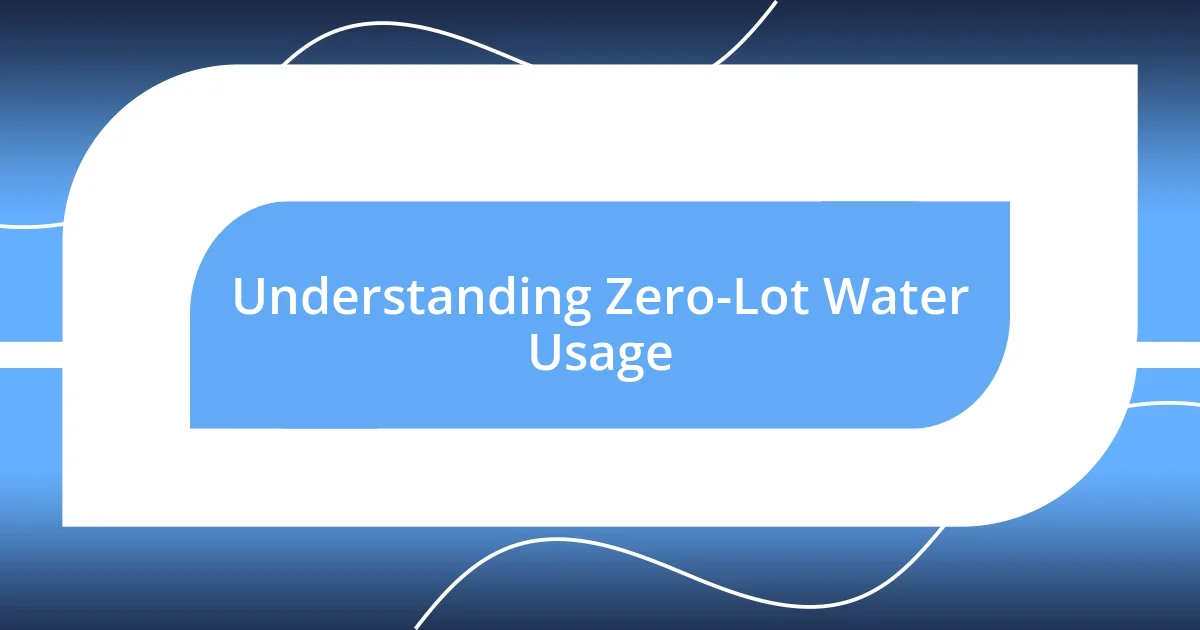
Understanding Zero-Lot Water Usage
Understanding zero-lot water usage revolves around the principle of minimizing water consumption in daily activities. When I first started this journey, I found myself constantly questioning how much water I really needed. It’s surprising how often we overlook the impact of small daily choices, like leaving the tap running while brushing our teeth.
As I dived deeper into the concept, I was struck by the idea that every drop matters. Imagine standing in your garden, realizing that even a small adjustment in your watering technique could save gallons of water. I remember a time when I switched to drip irrigation for my plants; not only did my water usage decrease dramatically, but my garden thrived like never before.
Being mindful of zero-lot water usage isn’t merely about cutting back; it’s an opportunity to innovate our habits. How would your life change if you embraced this mindset? I often wonder if more people understood the potential for both personal and environmental growth, they’d join the movement. It’s empowering to think that with some simple shifts, we can truly make a difference.

Importance of Water Conservation
Water conservation isn’t just a necessity; it’s a responsibility we carry for future generations. I vividly remember the day I got my water bill and felt overwhelmed by the costs associated with my usual habits. It ignited a passion within me to explore how I could contribute to conserving water. The changes I made not only eased my financial burden but also fostered a sense of pride in doing my part for the planet.
Moreover, conserving water can lead to surprising benefits beyond just saving the resource itself. I once joined a community cleanup initiative that focused on preserving local water bodies. Witnessing firsthand the pollution and waste made it clear how interconnected our choices are. By reducing my water usage, I’m not only lessening the strain on local ecosystems but also setting an example for my peers and inspiring them to act.
It’s essential to recognize that every small action contributes to a larger movement. I feel a genuine sense of joy when I see others adopt water-efficient practices. From replacing my traditional showerhead to a low-flow model to installing rain barrels for my garden, each choice is a step toward a sustainable lifestyle. The question really is: are we ready to embrace the meaningful changes that can redefine our relationship with water?
| Aspect | Traditional Usage | Water-Conserving Approach |
|---|---|---|
| Daily Showers | 15-25 gallons | 2.5-5 gallons |
| Toilet Flushes | 3-5 gallons | 1.28 gallons |
| Irrigation | Water waste due to evaporation | Drip irrigation systems |
| Watering plants | Daily watering | Using rainwater or drought-resistant plants |
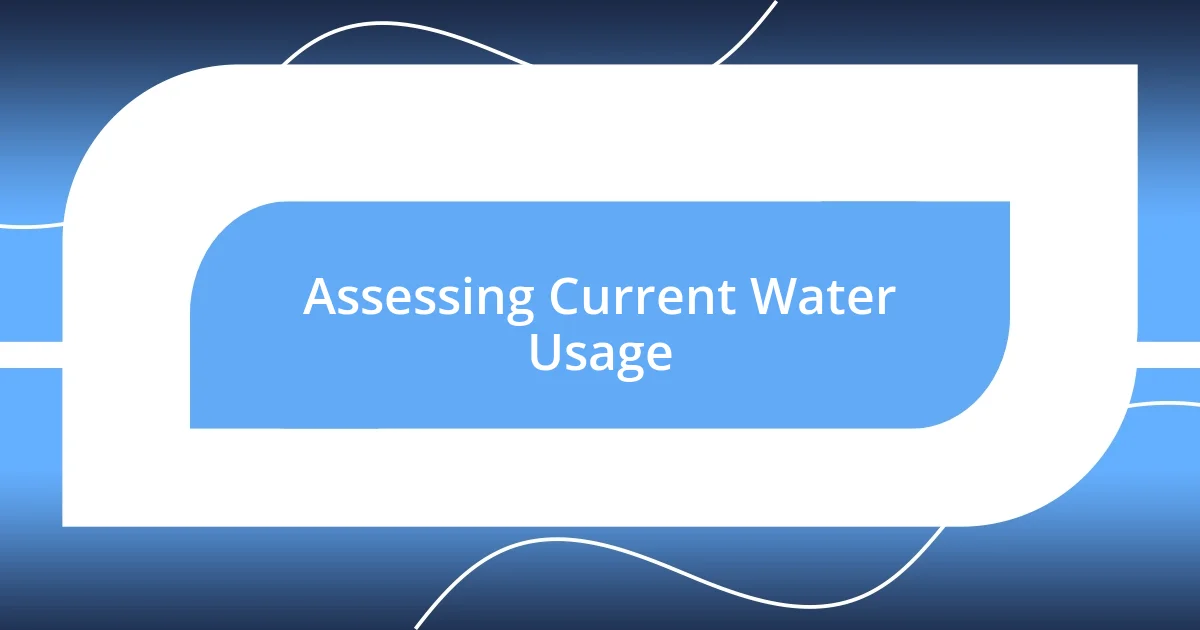
Assessing Current Water Usage
Assessing my current water usage was an eye-opening experience. I decided to track my daily consumption for a week, and the results were astonishing. I realized that many of my daily activities, which I had never thought to question, contributed significantly to my overall usage.
To help visualize this, here are some insights from my tracking:
- Morning Routine: I was shocked to discover I used about 20 gallons for my morning shower alone. Switching to a timer and cutting down on the time made a substantial difference.
- Gardening: I learned my traditional watering method wasted precious water through evaporation. I now collect rainwater and use it strategically to nourish my plants.
- Kitchen: Each time I rinsed dishes or washed vegetables, I noticed the water flow added up quickly – a habit I’ve since replaced with a basin for washing.
Recognizing these details not only taught me about my personal habits but also sparked a realization about the broader implications of our actions. I feel it’s essential to delve deeper into this understanding and embrace a mindset focused on conservation. After all, every change I made started with assessing where I was.
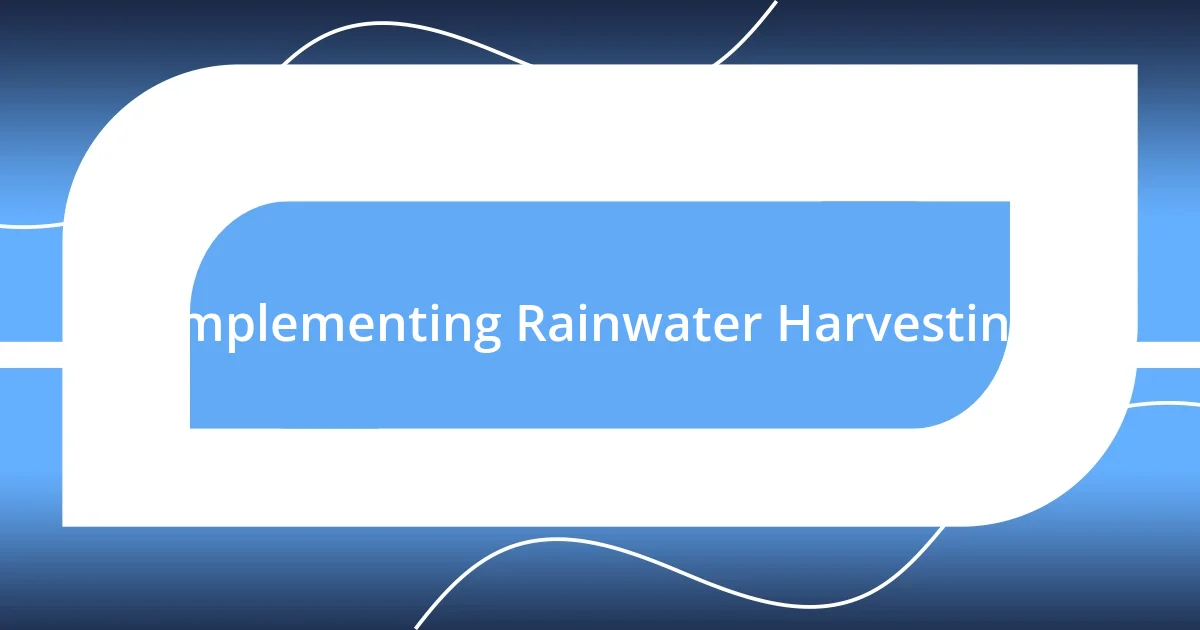
Implementing Rainwater Harvesting
Implementing rainwater harvesting in my home was one of those changes that felt daunting initially, yet invigorating once I got started. I remember the day my rain barrels arrived; it was like a turning point in my sustainability journey. Suddenly, the potential of capturing nature’s free resource was in my hands. It made me wonder, how many homeowners overlook this simple yet impactful method?
Setting up the system was surprisingly straightforward. After some research and planning, I installed the barrels beneath my downspouts. It’s amazing to see how much water collects during even a light rain. I’ve turned a mundane task into an opportunity for conservation. Plus, using rainwater for my garden has allowed me to cultivate a flourishing space without tapping into the municipal supply. Have you ever considered how much your garden could thrive on rainwater?
One of the most rewarding aspects of harvesting rainwater has been the sense of satisfaction it brings. Each drop collected feels like a small victory against wastefulness. I’ve learned to appreciate the rhythm of the seasons more closely, knowing that my garden relies on the natural cycles around me. With every storm, I find myself smiling, anticipating the treasure stored in my barrels, and asking myself: isn’t it phenomenal how nature provides for us if we just take the initiative to catch it?
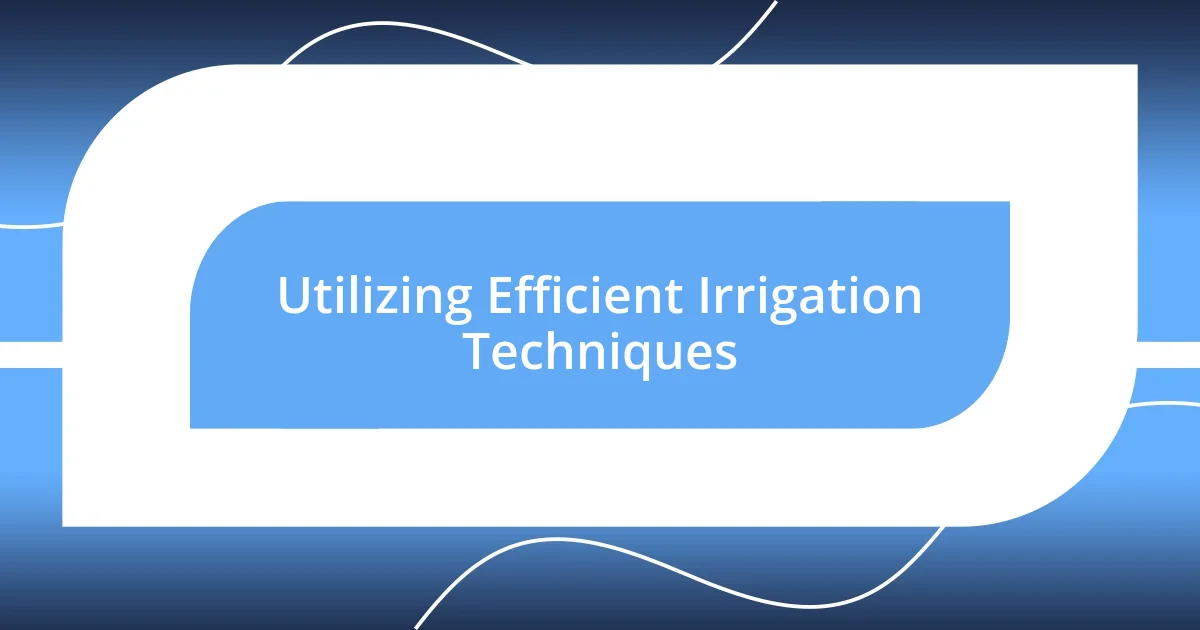
Utilizing Efficient Irrigation Techniques
Efficient irrigation techniques have transformed my gardening experience immensely. I remember shifting from conventional sprinklers to drip irrigation and was astonished by the water savings. With drip systems, water drips directly to the roots of my plants, minimizing evaporation and runoff. Have you ever wondered just how much more effective targeted watering can be?
I also started incorporating soil moisture sensors into my routine. These little devices provide real-time data on when my plants actually need watering. The first time I checked the readings and realized I didn’t need to water on a day I’d planned to, it was like discovering an extra day in my week. The beauty of technology is that it helps us make informed decisions, doesn’t it?
Lastly, adopting mulching techniques has been a game-changer. I layer organic materials around my plants, which helps retain soil moisture and reduces irrigation frequency. When I first did this, the vibrant colors and health of my plants skyrocketed. Seeing how much a simple layer of wood chips can contribute to water conservation genuinely inspires me. Have you considered the power of mulch in your own garden? It’s these little changes that showcase how efficient irrigation not only preserves water but also nurtures our green spaces.
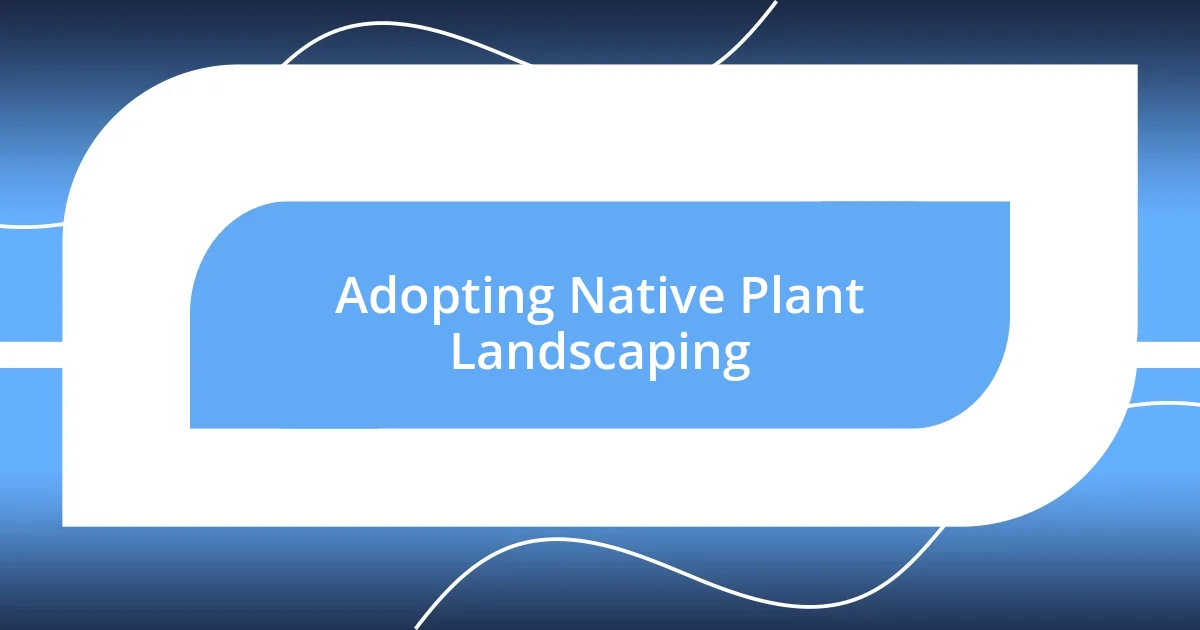
Adopting Native Plant Landscaping
Adopting native plant landscaping has been one of the most fulfilling decisions in my journey towards reducing water usage. I remember the first time I swapped out my thirsty ornamental plants for native varieties. The shift was not just a change in flora; it felt like aligning with nature. Have you ever considered how much easier it is to care for plants that naturally thrive in your local conditions? It was like finding the perfect puzzle piece that fit seamlessly into my landscape.
What surprised me the most was how little maintenance these native plants required. For instance, my local wildflowers flourished without constant watering, unlike the non-natives that often sulked in the heat. Every time I walked past my garden and spotted bees buzzing around the blossoms, it brought an unexpected joy and sense of connection to my surroundings. It made me think: why wouldn’t everyone want this joy in their own backyard?
The aesthetic appeal of a native landscape is simply stunning. I often find myself taking a moment just to appreciate how vibrant and alive my garden feels. Birds, butterflies, and even the occasional rabbit have become regular visitors, creating a lively ecosystem right in my own yard. It’s captivating to witness how the simple act of choosing the right plants can not only conserve water but also enhance the beauty and biodiversity of my environment. Have you thought about what native plants could do for your garden? I assure you; it’s a transformation that connects you deeply with your local ecosystem.
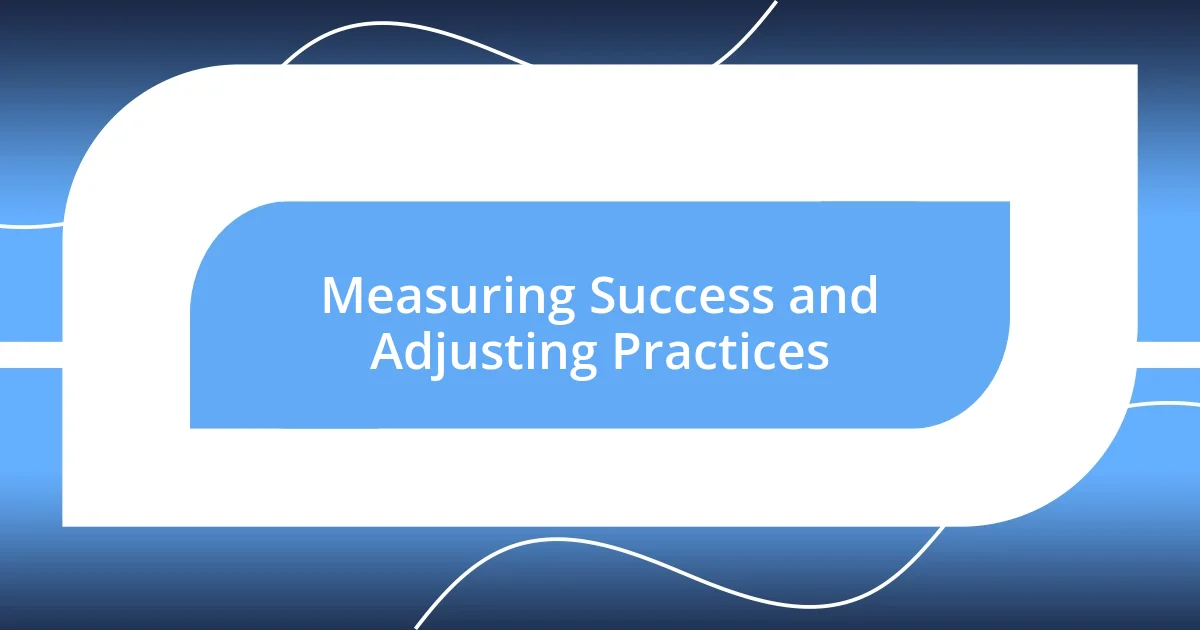
Measuring Success and Adjusting Practices
Tracking progress in water conservation is essential for any gardener on a zero-lot journey. I remember celebrating the first time I looked at my water bill and saw a noticeable drop—what a validation of my efforts! Each month, I keep tabs on my usage, not only to see if I’m on the right track but also to identify what changes have the biggest impact. Have you measured your success in any aspect of gardening? It’s incredibly empowering to see the tangible results of my choices.
Adjusting practices based on these measurements is key to continuous improvement. For instance, when I noticed that some areas of my garden were still too thirsty, I investigated further. I began experimenting with various mulching types and discovered that straw worked better for my sandy soil compared to wood chips. It made me think about how refining our techniques can lead to even greater levels of conservation. Are you open to tweaking your practices as you learn more? Embracing this process has enriched my gardening experience exponentially.
Emotions often guide our adjustments as much as data does. When I first tried using rain barrels, I felt a rush of excitement every time I collected enough water to nourish my plants. It became a little ritual—savoring every drop. That experience taught me to embrace small wins and celebrate every step toward my goal. I genuinely believe that measuring success leads to deeper connections with our gardens. Have you found joy in celebrating your milestones? Each achievement encapsulates both a strategy and a sense of accomplishment that fuels the journey ahead.












